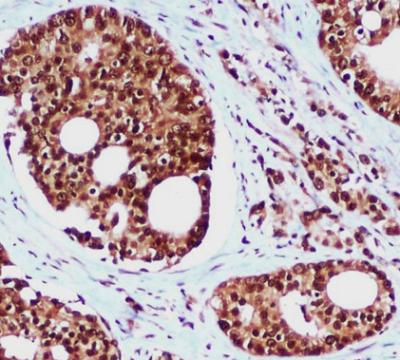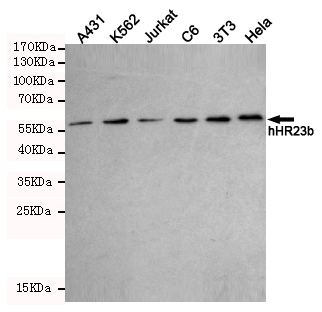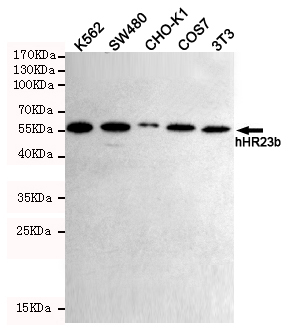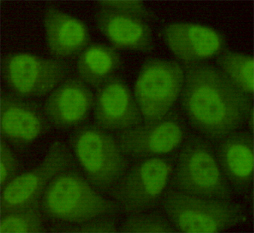-
Product Name
Anti-Rad23B/hHR23b (5H1) Mouse antibody
- Documents
-
Description
Rad23B/hHR23b (5H1) Mouse monoclonal antibody
-
Tested applications
WB, ICC/IF, IHC-P
-
Species reactivity
Human, Mouse, Rat, Monkey, Hamster
-
Alternative names
hHR 23b;hHR23B;HR 23B;HR23B;mHR 23B;mHR23B;P58;RAD 23B;RAD23 (S. cerevisiae) homolog B; RAD23 homolog B (S. cerevisiae);RAD23 homolog B;RAD23 yeast homolog of B;RAD23B; RD23B_HUMAN;UV excision repair protein RAD23 homolog B;XP C repair complementing compl antibody
-
Isotype
Mouse IgG2b
-
Preparation
Antigen: Purified recombinant human hHR23b protein fragments expressed in E.coli.
-
Clonality
Monoclonal
-
Formulation
Purified mouse monoclonal antibody in PBS(pH 7.4) containing with 0.02% sodium azide and 50% glycerol.
-
Storage instructions
Store at 4°C short term. Store at -20°C long term. Avoid freeze / thaw cycle.
-
Applications
WB: 1/1000
;ICC: 1/100;Other 1/1000
-
Validations

Immunohistochemical analysis of paraffin-embedded Prostate Cancer using hHR23b mouse mAb (1/100 dilution).Antigen retrieval was performed by pressure cooking in citrate buffer (pH 6.0).

Western blot detection of hHR23b in A431,K562,Jurkat,C6,3T3 and Hela cell lysates using hHR23b mouse mAb (1:1000 diluted).Predicted band size:58KDa.Observed band size:58KDa.Exposure time:5min.

Western blot detection of hHR23b in K562,SW480,CHO-K1,3T3 and COS7 cell lysates using hHR23b mouse mAb (1:1000 diluted).Predicted band size:58KDa.Observed band size:58KDa.Exposure time:5min.

Immunocytochemistry staining of HeLa cells fixed with 4% Paraformaldehyde and using anti-hHR23b antibody (dilution 1:100).
-
Background
Swiss-Prot Acc.P54727.The protein encoded by this gene is one of two human homologs of Saccharomyces cerevisiae Rad23, a protein involved in the nucleotide excision repair (NER). This protein was found to be a component of the protein complex that specifically complements the NER defect of xeroderma pigmentosum group C (XP-c) cell extracts in vitro. This protein was also shown to interact with, and elevate the nucleotide excision activity of 3-methyladenine-DNA glycosylase (MPG), which suggested a role in DNA damage recognition in base excision repair. This protein contains an N-terminal ubiquitin-like domain, which was reported to interact with 26S proteasome, and thus this protein may be involved in the ubiquitin mediated proteolytic pathway in cells. Alternative splicing results in multiple transcript variants encoding distinct isoforms.
Related Products / Services
Please note: All products are "FOR RESEARCH USE ONLY AND ARE NOT INTENDED FOR DIAGNOSTIC OR THERAPEUTIC USE"
